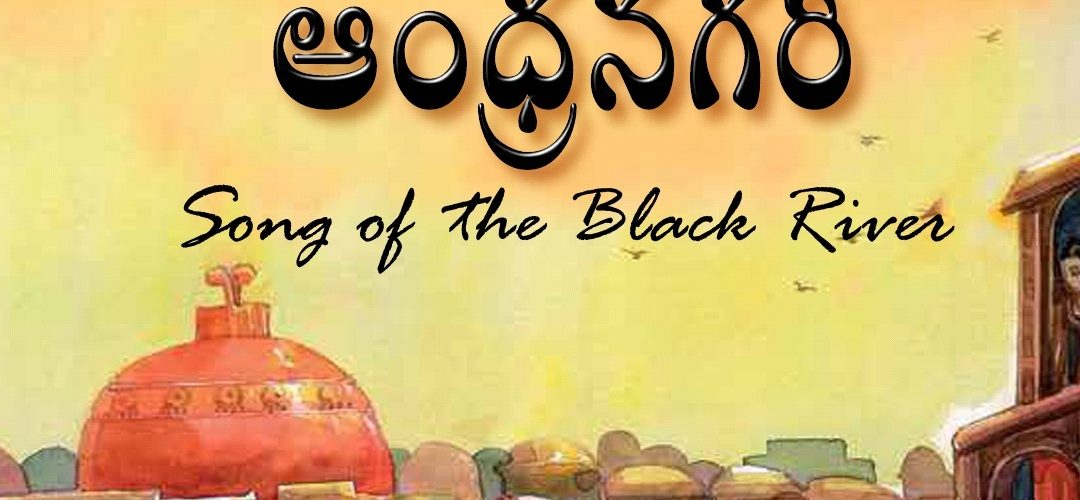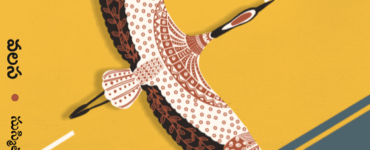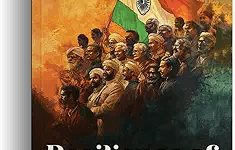Sai Papineni’s Amaravati Katha, Andhranagari, Song of the Black River; Sahiti Prachuranalu, Vijayawada; June 2013 & August 2019: Price: Rs300, Pp229 (andhranagari@gmail.com)
The title Amaravati Katha, Andhranagari, Song of the Black River can easily be mistaken for the one we are today witnessing in the context of the political turmoils that surround the place Amaravati grabs our attention everyday as a disputed, still to be developed city. But when we open the book, we find this book has an altogether different context as it fulfils a very pressing need in more than one sense. This is a historical narrative based on the Amaravati of yester years and has little connection to the Amaraviati we read about in our newspapers today.
Now when we come to Sai Papineni’s Amaravati, Andhranagari Katha (The Story of the Black River). At the outset the author Sai Papineni makes his concern clear as he, along with many other intellectuals, feels that there is glaring gap in the knowledge bank of today’s generation as the education system totally bypasses the study of subjects like history geography philosophy and culture, with its focus only new age learning relating to globalized computer and software centric learning. He feels genuinely concerned that in literary scenario too the historical fiction that should to some extent contribute to an awareness of the history and culture of our land is failing to fulfil its expectations. One can say that his effort to revive the interest of the readers in history of the Telugu has succeeded to a large extent through these fictional narratives.
In the current Telugu literary scenario, we do not come across many writers focusing on historical fiction. The writers who have produced novels under this genre have mostly written more fiction than history. This is the historical story wherein the author through three distinct streams weaves the story of the early rulers of Andhra who ruled from Amaravati, situated on the banks of the river Krishna. Krishna means dark as the waters of the river are dark. She is witness to the history, its art and architecture nurtured by the kings of Hindu and Buddhist religions.
The first stream relates, through their conversation, to the zamindar Venkatadri Naidu of local Chintapally and he discusses with his assistant the draught in the area and the inability of the farmers to pay the tax and the scarcity of grains and the zamindar plans to request the collector for assistance. They represent their request for the sanction of the grain and the British officers of the East India Company were in turn were happy to give the help required provided a settlement is established there where people of the area can work for the British army and the govt would provide them with the extra assistance. . They were busy entertaining the representatives of Queen Col. Meckanji, Capt Goodworth, and Mr. Mecalin as the process of establishment of British Empire began just at that time around 1797. It emerges the visit of the queen’s representatives happens to be the intent of the British representatives who recognised the worth of these art pieces lying in and amongst ruins and to put in place the modalities of transporting the art pieces and sculptures that were discovered there. The relics of the architecture and sculptures reflecting the glory of both Hindu and Buddhist religions were found to be immense interest to the British and they planned to take them to Madras and then to the British Museum subsequently.
The second stream relates to the identification of archeological evidences that establish that Andhras existed in ancient India. A mention of Andhras was found Atreyapurana, Mahabharatha makes a reference to it, Megasthnese talks about it- Andhra Satavahana kingdom was established in 230 BC at the time of the decline of Mauryan Empire.
The third stream relates to the Buddhism that played a dominant role in the establishment of Satavahana Kingdom immediately after decline of Ashoka’s Mauryan empire. Andhras ruled over a region covered between Mulaka, Ashmika, Mahendra and Vanavasis. Pratistanapuram, Podhanyam, Pishtapuram, Vijayedram, Srikakulam, Udayaramam, Suvarnagiri and Brahmagiri were some of the known cities of the time. Satavahana kingdom was founded by Srimukha Satavahana in 230 B.C almost at the end of Mauryan king Ashoka’s rule. (See Map on page 19) Andhras who were called Andhra Brityus, established friendly relations with kings of Kalinga and Vanga regions.
The third stream one can perceive as the influence of Budhusm on the history of Andhra and its early rulers. The kings were also greatly revered by the monks of the Buddhist araamas and the acharyas heading them, acharya Nagarjuna being the most prominent among them. He also touches on the possible connection between Kalinga and Maurya kingdoms as Ashoka could have married the queen Charruvaki who was later called Thishyarakshita. Being a Buddhist, she could be instrumental in King Chandaskoka becoming Ashoka, an advocate of non-violence and peace after the Kalinga war.
Throughout the anxiety of the author to bring forth the indifference and ignorance of the andhras to their cultural heritage can be seen quite significantly as he keeps coming back to the the three friends whose visit inspired the whole story. Here the link to the past is established by the total ignorance which comes from a basic indifference in the present-day India, the lop-sided understanding of history caused by written, rewritten, glorified, modified and deleted aspects of history in the school textbooks, which has always been dictated by the political ideologies of the successive governments. One interesting and unique feature of Sai’s narrative is that he rests his narrative firmly on credible sources of information and tells the readers at every step the source on which he based his fiction. This gives credibility to the story and makes one conscious of our past and its strengths and weaknesses. While Mackenjis’s Kaifeeyats, the presence and the role played by James Brady in the preservation of the Buddhist relics as he first recognised the greatness of the sculptures, and the writings of historians like Rapson, Vincent Smith and Bhandarkar were other sources that guided the writer Sai. He also speculates on the assumption that Amaravati Stupa could be the samadhi which formed the base for the Shiva temple that was built by eastern Chalukya King Bheema in 10th Century.
Sai Papineni weaves his fiction on this history and authenticates his story by telling us the background. While history is true, his story is fiction. The readers will enjoy the story as it is a racy narration and the author dots it with titbits of historical information in the inboxes at every stage. Second part of the book focuses on the fictional aspect. It begins with the visit of Nagasena a brother of queen Charuvaki Devi to the Satavahana kingdom to establish friendly relations with the rulers. His voyage begins on an auspicious note when he ends up marrying the daughter of a army commander in the Satavahana kingdom. He was imprisoned in a Buddhist monastery by the head of that ashram and he was subsequently rescued by Satavahana king. He becomes an important Samantha of Vashishti putra Satavahana. The reader will the enjoy the story but he will also learn the facts of history. An altogether captivating book which makes you regret that it is over when you come to the last page. Only the readers who enjoy popular fiction may not find it racy and gripping as at every stage the narrative is dotted with historical titbits and one has to move along in the story absorbing these historical contexts. I have no intention of narrating the entire story and spoiling the fun. All good things need to end after all.
*









Good piece of writing on the book of genre so rarely keeps coming out among us. Yes, historical books entwine with fiction and sometimes which makes the reader hyperbolic about facts. There ends the enthusiasm. However a welcome phenomenon being discussed things like this .Have a nice day.
It was a good review. But with due apologies, I would like to point out certain deviations from the original text .
“Ashoka could have married the queen Charruvaki who was later called Thishyarakshita. Being a Buddhist, she could be instrumental in King Chandaskoka becoming Ashoka, an advocate of non-violence and peace after the Kalinga war.”
But Sai Papineni clearly mentioned that Asoka had three wives. His first wife Videsamahadevi was a Buddhist who died much earlier. “Asandhitamitra” was Pattamahishi. After her death his second wife “Tishyarakshita” became Pattamahsihi. She was against Buddhism. There was a rumor in those days that she was responsible for poisoning the Mahabodhi tree. In the Allahabad pillar, it was mentioned that the second wife ‘Karuvaki’ So probably Tishya rakshita could be Karuvaki.
In continuation of the review, I would like to point out another deviation.
“He also speculates on the assumption that Amaravati Stupa could be the samadhi which formed the base for the Shiva temple ”
In the third chapter, he clearly mentions that the Ayaka pillars of Amaravathi stupa and the stone used for Amareswara linga are the same types of marble. The method of placing another sculpture on the pillar by nailing it to the pillar is one method that was used in the construction of the stupa. There was this tradition of applying Sindhura to the Buddhist stupas. One can find these marks of Sindhuram on other pillars excavated at this place. These marks look similar to the marks on the Amareswara linga. The Sthalapurana says that there are marks of iron nails nailed on the top of the linga.
Nowhere he mentioned that the Amaralingeswara temple was built on the samadhi of Buddha.
The book is not about the kings but the common man who might have lived in those times.
I request the reviewer to please correct me if I am wrong
“I request the reviewer to please correct me if I am wrong”
I thank the respondent Prasunagaru for her comments.
Well, I cannot say she is wrong. But surely and clearly we are not on the same page .
Her first observation: She is correctly referring to the inbox in the page where the author gives details about Asoka’s marriages and his wives. That is historical reference. In the same page in the fiction part where I was focusing last paragraph refers to the reassurance given by Tishya to Mallika and he says, ” you need not worry about the safety of your queen. Your sakhi will hereafter be known not as Queen Charuvaki but as the one in protection of Tishya who is the representative of all the Boudhaa sanghas in Karnata, Andhra and Kalinga desas and she will be known as Tishyarakshita, one protected by Tishya. All the boudha sanghas of Dakshinadesa will lay down their lives to protect her” this when they were trying to convince her about marrying Asoka to safeguard her land from his onslaught. Kalinga has already suffered not only a defeat but the criel king turned the whole land into a barren land by the bloodshed caused and deaths inflicted by this war. It was a strategic necessity to avert war and bring peace the land. So she was clearly not against Budhism, but very much under influence of the acharyas of te day. This is fiction what exactly is history was given in the same page. (p76)
Second deviation as you called it: Amareswara temple. By the way I visited the temple when I came to Vijayawada and heard the story of the lingam gowing and how it was nailed from growing any further. At that time I was not aware of the Budhist connection. Historical reference cites that it was constructed during the 10th century AD by a eastern chalukya king Bheema. The author mentions the lingam could be one of the pillars of the the stupa though it is not proved substantially. that is the speculation part It could the autor or the historians who were infering this. You are right. It was not a smadhi,which is the base it was apillar from the stupa. That is a mistake. However,this is new information to me. So I added.
As a matter fact I admit that I could not weave through or connect the links as adeptly as the author who is no doubt a scholar and knows what he is talking about. In a review it is difficult to bring in every aspect as there is a space constraint which fortunately is not the concern of the writer. I am not a historian but read a lot of historical fiction. William Dalrymple in his White Mughal follows the same kind authentication for his fictional narrative. Fiction should not distort history, nevertheless history also in its turn should not become a burden on the narrative impending its readability,
Thank you I hope this satisfies you.